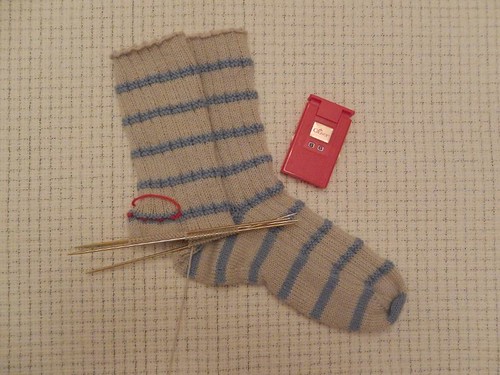
One milestone of note is we're currently in the midst of the sesquicentennial of the American Civil War (1861-65). There have been and will continue to be many observances, particularly around various battles and civil rights advances. Earlier I was too preoccupied, but more recently I've been keeping DH company on visits to some of the numerous national parks that preserve old battlefields large and small.
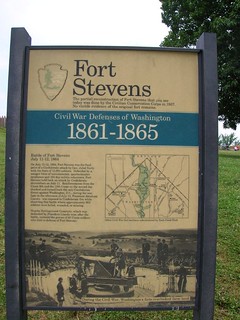 Last weekend we went on a walking tour featuring the smallest national park I've ever visited, Fort Stevens, part of the Civil War defenses of Washington, DC and the namesake for the Battle of Fort Stevens, July 11-12, 1864, which President Lincoln observed. The smallest national cemetery I've ever seen, Battleground National Cemetery, was also part of the tour. Park Ranger Mike gave an excellent, informative talk and encouraged questions. Thank you, Ranger Mike!
Last weekend we went on a walking tour featuring the smallest national park I've ever visited, Fort Stevens, part of the Civil War defenses of Washington, DC and the namesake for the Battle of Fort Stevens, July 11-12, 1864, which President Lincoln observed. The smallest national cemetery I've ever seen, Battleground National Cemetery, was also part of the tour. Park Ranger Mike gave an excellent, informative talk and encouraged questions. Thank you, Ranger Mike!It's astonishing to think of Washington as a heavily fortified city, completely ringed by forts and artillery batteries built largely by escaped slaves (.pdf map). Until the abolition of slavery in 1865, enslaved African Americans were considered property in much of the U.S., including the District of Columbia, and runaways were considered contraband. The contraband camps that formed around the forts during their construction and that persisted after became some of the first black neighborhoods of the city. This heritage is historically significant yet severely under-documented. To remedy that, the National Parks Service is seeking African Americans with ties to these neighborhoods to record their stories. Not to mention it would be nice to see more diversity in Ranger Mike's audience.
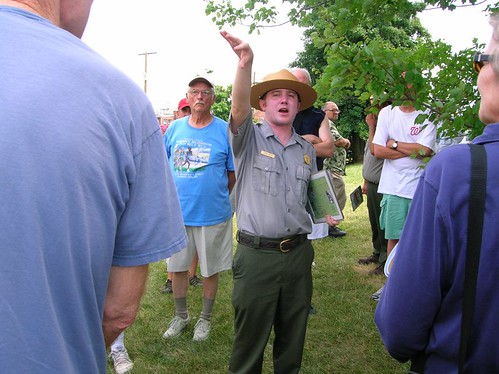
History tells us it was hot and humid 150 years ago, and so it was when we took the walking tour. I was very grateful I was wearing light clothing and sunscreen (but I forgot my hat), carrying little, and had access to shade and chilled water provided by the NPS and was not wearing a wool uniform and carrying a 60-pound (27 kg) military pack and a 10-pound (4.5 kg) musket, with orders to charge the abatis surrounding the fort. History further tells us that when some Confederate soldiers looted the Silver Spring mansion of Montgomery Blair (a member of President Lincoln's cabinet and one of the lawyers who unsuccessfully represented Dred Scott), they so enjoyed the barrels of fine whisky they discovered in the basement that the next morning they were unable to make an early start. Had they done so, this is part of what they would have seen: tall earthworks crowned by battlements and 30-pound Parrott cannons commanding the high ground, with neighboring forts providing interlocking fields of fire. Imagining it all gave me a little shiver.
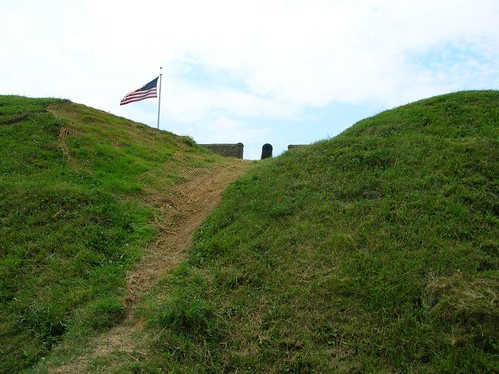
The anniversary events drew modest crowds of tourists and re-enactors, including some Confederate re-enactors who became upset the Parks Service wouldn't let them in the park with their historic battle flags, which are banned because of their equally historic use by hate groups. The would-be Rebels sorta complied – they stood on the public sidewalk with flags half-furled and yelled rude things at passersby. I declined to take their pictures.
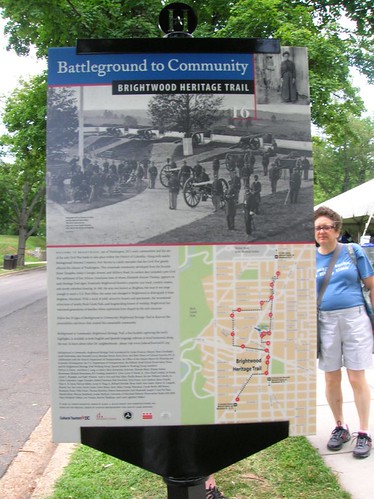
DH was surprised and very pleased by the outing. He's visited a fair number of old battlefields, some famous, some obscure, some hard to find. Even though less than half of the little fort is standing, DH pronounced the remnants among the best-preserved Civil War era earthen battlements he's ever seen. The location, inside the District, is easily reached. There is free street parking, but no amenities at the site; however, the park is in the urban residential neighborhood of Brightwood, which has all the conveniences. The ground is uneven and sloping, sensible shoes are helpful. There are no barriers to wheelchairs, but no improvements for them either. Those who miss a guided tour can easily follow the well-marked signs for a self-guided tour. I'd say for those with the time and inclination, it's worth a visit, but for those making the whirlwind tour of major monuments and museums in Washington, it's easily skipped.
No comments:
Post a Comment